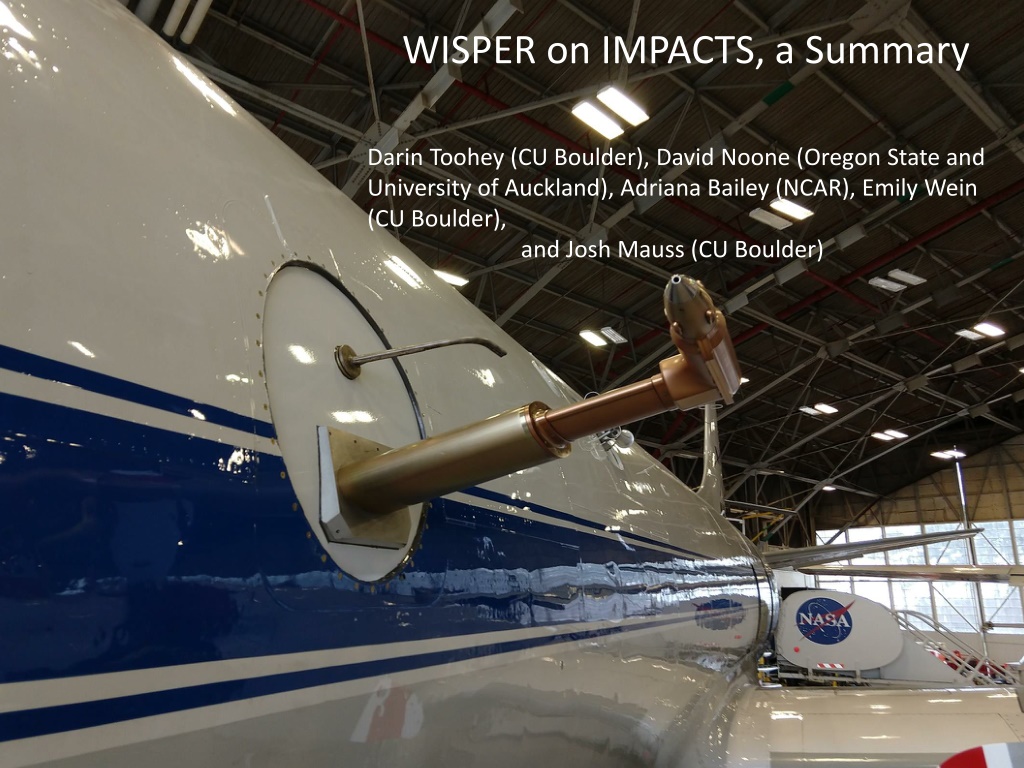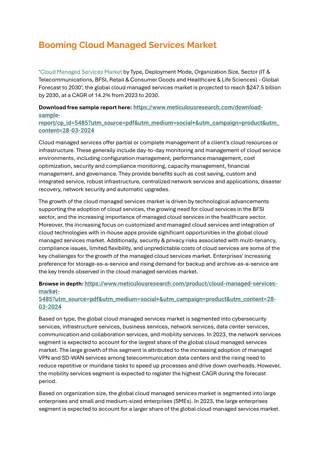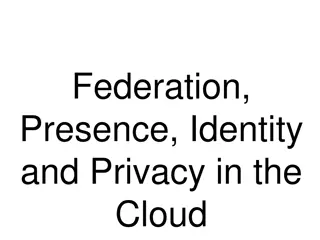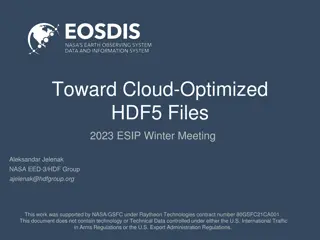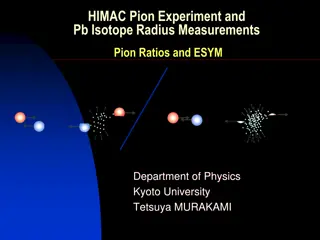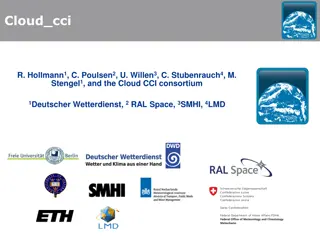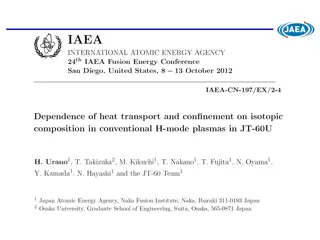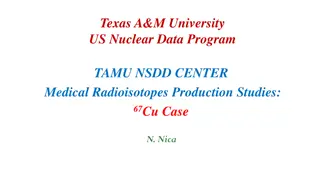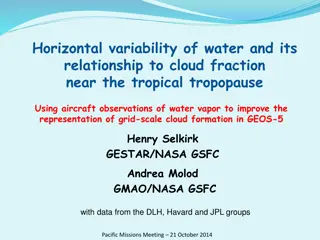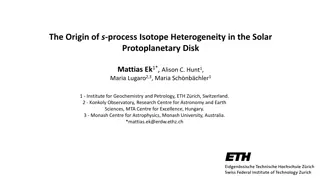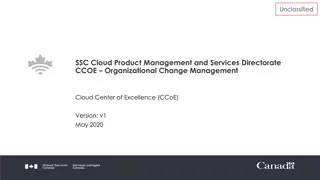Water Isotope System for Cloud Research
Water Isotope System for Precipitation and Entrainment Research (WISPER) utilizes advanced spectrometers to measure water vapor and isotopologues in clouds. The system helps in understanding cloud microphysics, droplet formation, and vapor transfer processes. However, it faces challenges such as condensation issues and icing of inner surfaces, impacting data interpretation and quality control.
Download Presentation

Please find below an Image/Link to download the presentation.
The content on the website is provided AS IS for your information and personal use only. It may not be sold, licensed, or shared on other websites without obtaining consent from the author.If you encounter any issues during the download, it is possible that the publisher has removed the file from their server.
You are allowed to download the files provided on this website for personal or commercial use, subject to the condition that they are used lawfully. All files are the property of their respective owners.
The content on the website is provided AS IS for your information and personal use only. It may not be sold, licensed, or shared on other websites without obtaining consent from the author.
E N D
Presentation Transcript
WISPER on IMPACTS, a Summary Darin Toohey (CU Boulder), David Noone (Oregon State and University of Auckland), Adriana Bailey (NCAR), Emily Wein (CU Boulder), and Josh Mauss (CU Boulder)
Water Isotope System for Precipitation and Entrainment Research (WISPER) System = counterflow virtual impactor with two cavity-ringdown spectrometers (CRDS) measuring water vapor, HDO, and H218O in clouds. Condensed water measurements use the same method as on the NSF G-V and C-130 aircraft when flying the NCAR CVI inlet (just different H2O sensors) OSU inlet was first flown during the 2017 ORACLES field intensive. Backward facing pick-off tube was added in 2020 to simultaneously measure vapor phase H2O; these measurements employed a slow- response Picarro CRDS (~30 seconds) and should be considered exploratory for the 2020 deployment.
Condensed H2O important for radar and lidar retrievals Also for validating measurements of ice water vs liquid water in mixed phase clouds, other cloud probes Vapor phase important for microphysics droplet formation, transfer of vapor between liquid and ice in mixed phase, and evaporation of precipitation Isotopologues can be useful for identifying source regions and microphysics (e.g. exchange of water between liquid and ice)
Water Isotope System for Precipitation and Entrainment Research (WISPER) System = counterflow virtual impactor with two cavity-ringdown spectrometers (CRDS) measuring water vapor, HDO, and H218O in clouds. Custom electronics for four stages of heaters and precise flow control (~1%), operating at 10 Hz to reduce oscillations due to pressure fluctuations A new version of control box is now flying on the NCAR G-V (SPICULE, 2021)
Limitations of Method (1) Conditions sampled by WISPER were outside the nominal design parameters of the CVI inlet. High CWCs (> 1.5 g/m3) result in condensation of enhanced water vapor on inner transfer lines of the inlet (mainly well downstream of the probe tip). This caps CWCs at an artificially low values in some clouds Reducing condensation requires high sample flow rates that raise the Reynolds number in the probe tip to > 2000, leading to turbulence and infiltration of ambient air. This does not impact the CWC significantly, but it makes interpretation of isotopologue correlations difficult. A balanced approach is used, which leads to an exponential increase in the level of QA/QC required to manually flag/correct data, which is the primary reason results from 2022 have not been exchanged.
Limitations of Method (2) Icing of the inner surfaces of the CVI probe were discovered in intercomparisons with other CWC measurements during the 2018 NSF SOCRATES project. The offending part is the porous tube used to allow dry air to pass Into the sample line with minimal turbuence. This tube is unheated, Becoming iced over in long flight segments in the presence of supercooled liquid water. The porous tube is being redesigned to eliminate this problem for the proposed SOCRATES II campaign, but will not be ready in time for IMPACTS 2023.
Condensed Water Contents Important things to know for 2020 and 2022 Cloud water contents were measured on all science flights in 2020 and 2022; known issues have been addressed iteratively and solved over the course of the two deployments. Absolute and final post-campaign water calibrations have been completed at < 5% accuracy for 2020 and 2022. CWCs for 2020 at ~10% (1 ) for most observations are on the archive. They are in units of g/kg air, as described in the accompanying summary document, and NOT as g/m3 as labeled in the files this will be corrected when 2022 results are submitted to the archive. Final CWCs for 2022 are available from the PI and are undergoing final QA/QC. Flags will be implemented to describe cases where data are removed. Email Toohey@colorado.edu
Important to know for 2022 CWC Measurements SF01 through SF06 employed the same fast-response Picarro water vapor analyzer for condensed water measurements as was used in 2020. For SF07 through SF11 a new fast-response analyzer from NCAR was swapped in for measurements of condensed water due to increasingly intermittent behavior of the older analyzer. The new analyzer had significantly better precision for measurements of isotopologues, but otherwise both have excellent precision for H2O.
Water Vapor Important things to know for 2020 and 2022 For all of 2020 and for SF01-SF04 in 2022, a slow-response (~10 s) Picarro CRDS measured water vapor in and out of clouds. In 2020, the water vapor inlet was not heated, and so the results are often contaminated by icing/condensed water on inlet surfaces in clouds. Data outside of clouds are mostly good. In 2022, heaters and bypass flow were added to the water vapor inlet, and measurements are of high quality for all flights. A 5 Hz Picarro (courtesy Adriana Bailey, NCAR) was added for SF05- SF11 in 2022, and the results are of very high quality these are the first measurements of water vapor isotopologues in clouds from aircraft.
Status of 2022 Water Vapor Measurements Significant modifications were made to the backward facing, vapor- phase inlet for 2022. Heat was added to the inlet (from inside the P-3) to reduce condensation of vapor on inner surfaces of the inlet. Air was pulled through the inlet at >0.4 SLM with a vacuum pump and bypass system, reducing the hysteresis from icing and condensation during large CWC events or when changing altitudes/temperatures. Excellent water vapor measurements were obtained on all flights. Three different Picarro water vapor analyzers were used in 2022. RF01-RF04 slow (12 second average) analyzer, also used in 2020 RF05-RF06 new, loaner from NCAR, fast-response analyzer RF07-RF-11 fast-response analyzer used previously for CWC
Examples of CWCs and Rhice (spoiler alert P-3 aircraft T seems to be biased high about 0.5 degrees) RF01-RF04 Response time too slow to distinguish some short periods of supersaturation with respect to ice (e.g., mixed-phase clouds) RF05-06 Significant short periods of supersaturation with respect to ice in regions of supercooled liquid water
Example of Variation of Isotopologues Note the significantly larger variation in isotopologues in condensed phase compared to vapor phase. These are the first measurements of condensed and vapor phase water from an aircraft with sufficient resolution to see the effect of individual hydrometeors evaporating in the inlet Color = Elapsed time (purple to red) The noise in the vapor phase (black) data points are due almost entirely to instrumental precision.
New for 2022 and 2023: Novel New Heater Flux Measurement At constant temperature, the duty cycle of the heater provides a direct measure of latent heat of evaporation. The value of CWC derived from this method is independent of the flow rate of sample air into the inlet this is because the flux of hydrometeors >10 m in diameter is determined simply by the product of air speed, cross- sectional area of the inlet, and condensed water content (g m-3) We will use this new, unique measurement on the CVI to validate the water-vapor based measurements of CWC.
Ongoing Work 2022 (1) Data analysis almost complete just labeling all the data with flags takeoff, blowout, counterflow off, ambient inlet, icing, saturation, and other instrument issue (2) Final 2022 Data Files for Exchange in about 2 weeks (goal before Thanksgiving). Will include all parameters reported by WISPER: 1-Hz Cloudwater contents, H218O, HDO, all flights 30-second averaged water vapor, H218O, HDO (SF01-SF04) 1-second water vapor, H218O, HDO (SF05-SF11) Will include new flags (3) Unflagged files available upon request just email PI (4) Updated files from 2020 will be generated over the coming weeks, but don t expect major changes. Water vapor will remain problematic. Flags will be added.
Status for 2023 (1) We won t have fast Picarro (NCAR) water vapor measurements in 2023. So 2022, SF05-SF11 represent unique opportunities for testing microphysics with fast CWC and vapor (2) Inlet was completely disassembled, some important problems identified and fixed (leaking O-ring, bad thermal connection to porous tube, and broken heater probably a long-standing issue) (3) Instrument/inlet at Wallops, will be integrated Monday and Tuesday, Oct 30-Nov 1 (4) Welcome Josh Mauss, new ATOC graduate student who will be helping with WISPER integration next week, and will be flying with WISPER in November-December and supporting WISPER with Darin in January-February 2023.
Summary (1) Some very interesting results during IMPACTS 2020 and 2022. Please use the data for any analyses. (2) Condensed water contents were much larger than ever measured before with a similar CVI inlet, and overall performance was better than expected under challenging conditions. (3) IMPACTS 2023 should be our best data if not, Darin will retire. More seriously, he is shifting back to stratospheric balloon and WB-57F measurements as CU professor, and will continue supporting CVI issues as a private consultant. Don t hesitate to reach out! Technical issues (Darin): toohey@Colorado.edu Big picture science questions (David):david.noone@auckland.ac.nz
